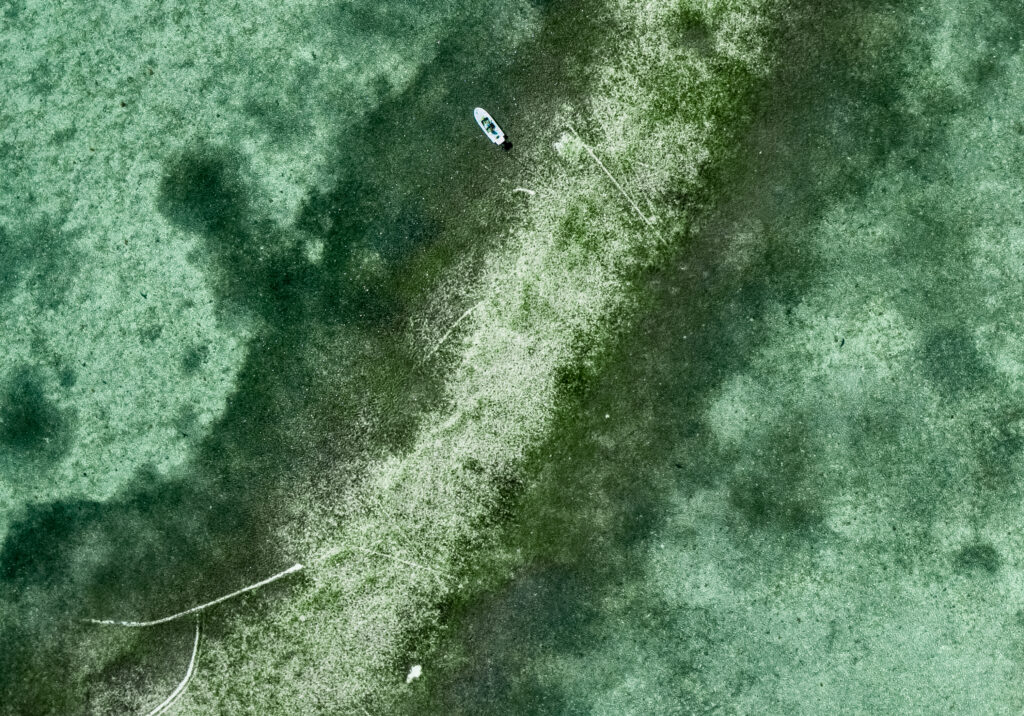Anglers fish a scarred flat in the Florida Keys. Photo: Tyler Bowman
Are you concerned about boats running over Keys flats and destroying vital habitats that will take years to recover? Then the Florida Keys National Marine Sanctuary’s proposed Restoration Blueprint should be on your radar.
The FKNMS draft management plan will influence access and use in the Florida Keys waters for the next 10 to 20 years. That’s why BTT is working in close collaboration with Florida Keys Fishing Guides Association (FKFGA) and the Lower Keys Fishing Guides Association (LKGA) to support a set of science-based recommendations that underscore the critical importance of habitat, water quality and enforcement—all to ensure that our shallow water habitats are adequately protected while also ensuring responsible access. The number of Keys flats classified as “severely degraded” due to propeller scarring has increased by 90 percent over the last 20 years. We must take action NOW to conserve and protect this vital habitat, or the Keys’ world-class flats fishery will continue to decline.
FKNMS released its Restoration Blueprint on July 12, 2022, beginning a 100-day public comment period. This week, BTT, FKFGA and LKGA submitted recommendations on the Blueprint that will increase protections for shallow water habitats while providing reasonable access. Our recommendations focused on the conservation benefits of the recommended zoning and evaluated access to these proposed zones.
The zoning proposed by BTT, FKFGA, and LKGA would protect 32,607 acres of seagrass and 8,048 acres of hardbottom habitats. That’s protections for almost twice the amount of seagrass habitat and 60 percent more hardbottom habitat compared to the zoning in the FKNMS Restoration Blueprint.
BTT, FKFGA, and LKGA’s zoning recommendations in the Marquesas Management region create two large contiguous areas to protect critical areas for permit. These areas not only support the historical center of the fishery, but are shown to be high centers of activity for acoustically tagged permit. Furthermore, one zone modification, Ballast and Man Keys Flats Wildlife Management Area, offers needed protections for shallow waters that are highly connected via permit migration to the newly established Western Dry Rocks spawning aggregation closure. Similarly, in the Upper Keys and Middle Keys Management Region, based on BTT’s acoustic tracking of bonefish, BTT, FKFGA, and LKGArecommended zoning would create three protected area networks that encompass the movements and home ranges of bonefish.
Though these zoning recommendations increase protections for shallow waters, zones do not overly restrict access. “No motor” zones proposed by BTT, FKFGA, and LKGA are no less accessible than those proposed by FKNMS, although the organizations’ “idle speed” zones are more restrictive in terms of distance needed to travel prior to reaching a zone border.
Additionally, BTT, FKFGA, and LKGA strongly support the development of a boater education program within the Sanctuary, like the one in place in Everglades National Park, that is comprehensive, mandatory and accessible to reduce negative interactions between boaters and natural resources.
In summary, BTT, FKFGA, and LKGA’s recommendations provide zoning that will benefit shallow water fisheries in Florida Keys National Marine Sanctuary while maintaining access for user groups. However, these recommendations must be considered as a foundation that can be built on through adaptive management, particularly in the Lower Keys and western Middle Keys Management regions. During this process, BTT and its partners will continue to be at the front lines to make sure appropriate actions are taken to allow the scars on our flats to heal, and that no new wounds are inflicted.
Click Here to read BTT’s comments on the FKNMS Restoration Blueprint. Click Here to read BTT, FKFGA, and LKGA’s Summary of Recommendations for FKNMS.




